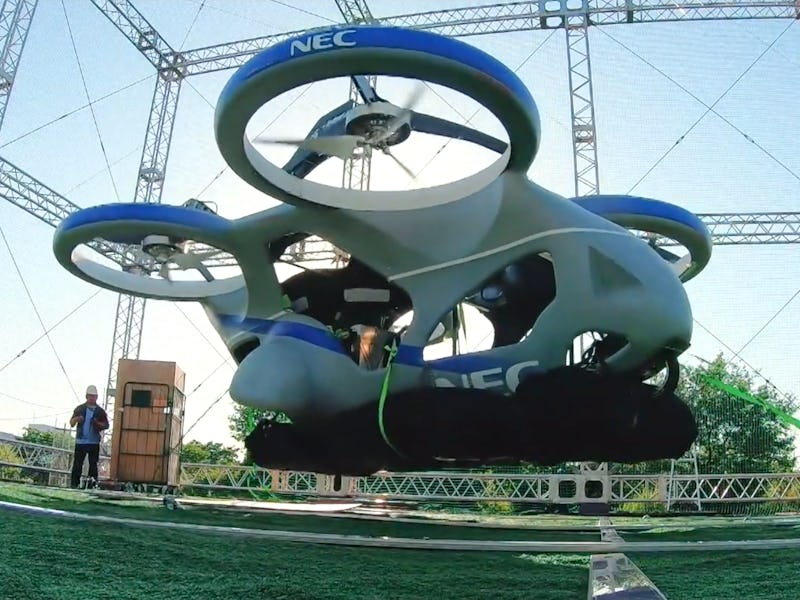Flying Cars Like Japan’s VTOL Are a Big Step Toward Zero-Emission Travel
They could pepper the skies soon.

The era of the flying car could soon be upon us, and with it, a new form of eco-friendly travel.
On Monday, Japanese electronics firm NEC took the wraps off a project a year in the making: a 330-pound battery-powered flying machine, developed in conjunction with partner Cartivator. The project lifted up 10 feet in the air and flew the length of a 65-foot cage located in the outskirts of Tokyo, a demonstration lasting just under one minute. Cartivator, which has been granted a permit for outdoor flights by the Japanese government, plans to start mass production of the car in 2026.
“Japan is a densely populated country and that means flying cars could greatly alleviate the burden on road traffic,” Kouji Okada, a leader of the project at NEC, told Bloomberg in a Monday story. “We are positioning ourselves as an enabler for air mobility, providing location data and building communications infrastructure for flying cars.”
It’s this developing infrastructure that could help electrify and clean an otherwise-dirty form of transport. Small, vertical takeoff and landing crafts that don’t require a runway could switch to electric power faster than larger jet engines. The sky could be set to fill with a patchwork of various flying machines, all of which will need to communicate with each other, and these first machines could lay the groundwork for a broader switch to clean methods of air-based travel.
Electric Flying Cars: How They Could Pave the Way for Zero Emissions
At this stage, electric cars have become something of a success story. In 2005 there were just a few hundred of the vehicles on the world globally, then by 2015 there were one million on the roads in total. Those figures rapidly shot up, and more than two million electric cars were sold in 2018 globally according to BloombergNEF. Electric cars are expected to comprise 57 percent of global sales in 2040 with sales of 56 million.
Cars have rapidly adapted to meet consumer needs. They got cheaper, drive further on a single charge, and replenish the battery in a shorter space of time. The median electric car available in the United States in 2011 could drive for just 73 miles per charge, but by 2017 that figure had reached 114 miles. Top-end vehicles in 2011 could only drive 94 miles, but the best in 2017 could reach 335 miles. Battery advancements and technological improvements have made the electric car a better product.
Despite these advancements, it’s going to be a while before air travel can go all-electric. For starters, weight is a much bigger concern with a flying machine. To create an electric jet, Tesla CEO Elon Musk has claimed that batteries would need to reach a density of 500 watt-hours per kilogram. Electric car batteries are around half that density, but Musk expects the industry to reach that figure in around five years’ time.
Ready for electrification? The jet plane.
But even with the energy density issue solved, smaller VTOL machines that look similar to the Cartivator design may be the first to electrify the skies. Thierry Marin-Martinod, aerospace and defense chief technology officer for TE Connectivity, told Inverse last month that smaller electric flying vehicles will start offering 20 to 30-minute journeys sometime before 2025.
“The battery is maybe the first hurdle,” Marin-Martinod explained. “As soon as you solve the battery, you have the high voltage. And we are working on it. And after that is rules and regulation.”
Over time, a patchwork quilt of flying machines could pepper the skies and provide eco-friendly travel for short and long distances. Machines will need to communicate with each other effectively, ensuring safe travel and synced-up flight patterns to move everyone around at speed. From there, hybrid jets would take off around 2025 or 2030, with a fully-electric jet taking off around 2040.
Who will supply these small flying machines? Uber has expressed a strong interest, planning test flights next year before starting commercial operations in 2023. The company plans to use Dallas, Los Angeles and Melbourne to trial flights for the price of an UberX, cutting down the 11-mile trip from Melbourne’s business district to the airport from an hour by car to just 10 minutes. As with other VTOLs, the absence of a runway makes them better suited for cities and other places where space is an issue.
Over 120 electric VTOL vehicle projects are in the pipeline, which could enable the cities of the future to move around with ease. ResearchandMarkets.com predicts the market will grow 19.5 percent annually from 2017 to 2024. Their success could pave the way for completely electrifying the skies.
Monday’s demonstration may be one small step for a little machine, but it could result in one giant leap for the flying machine industry.